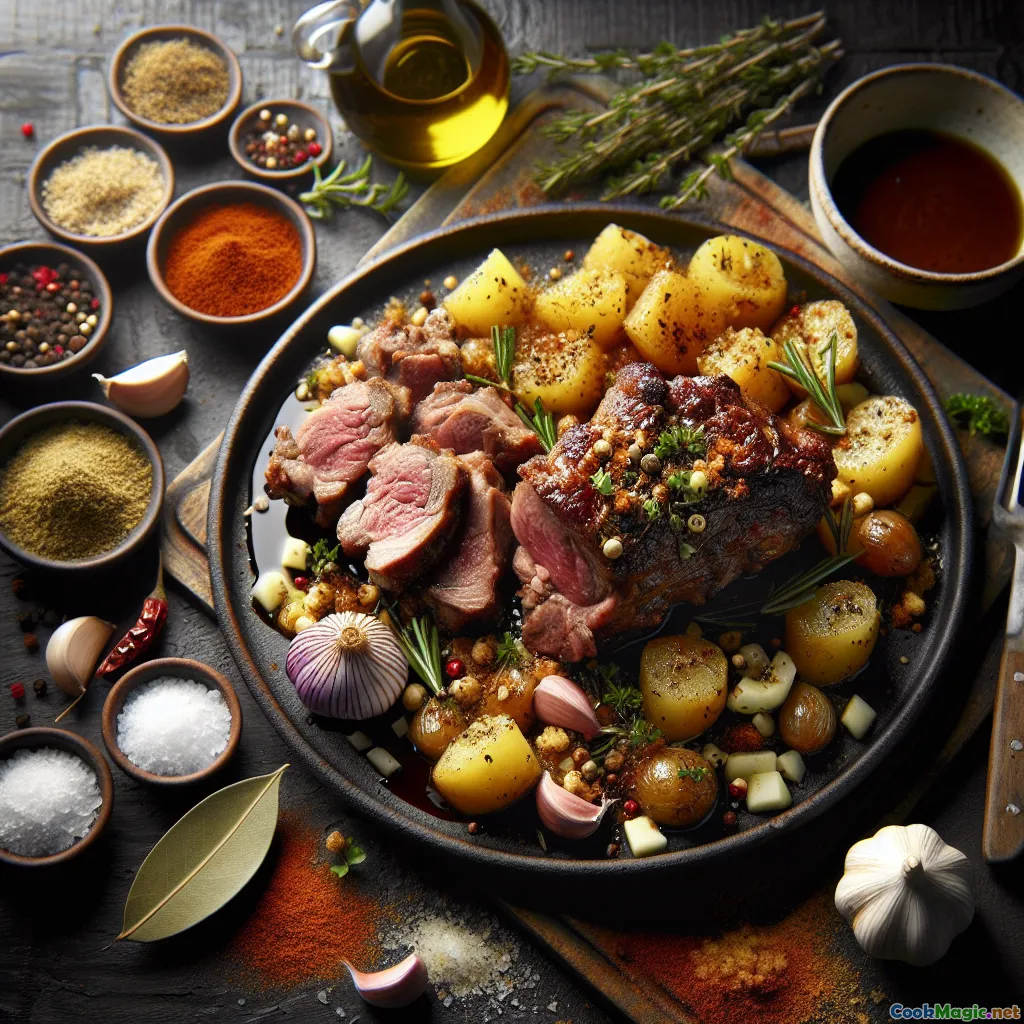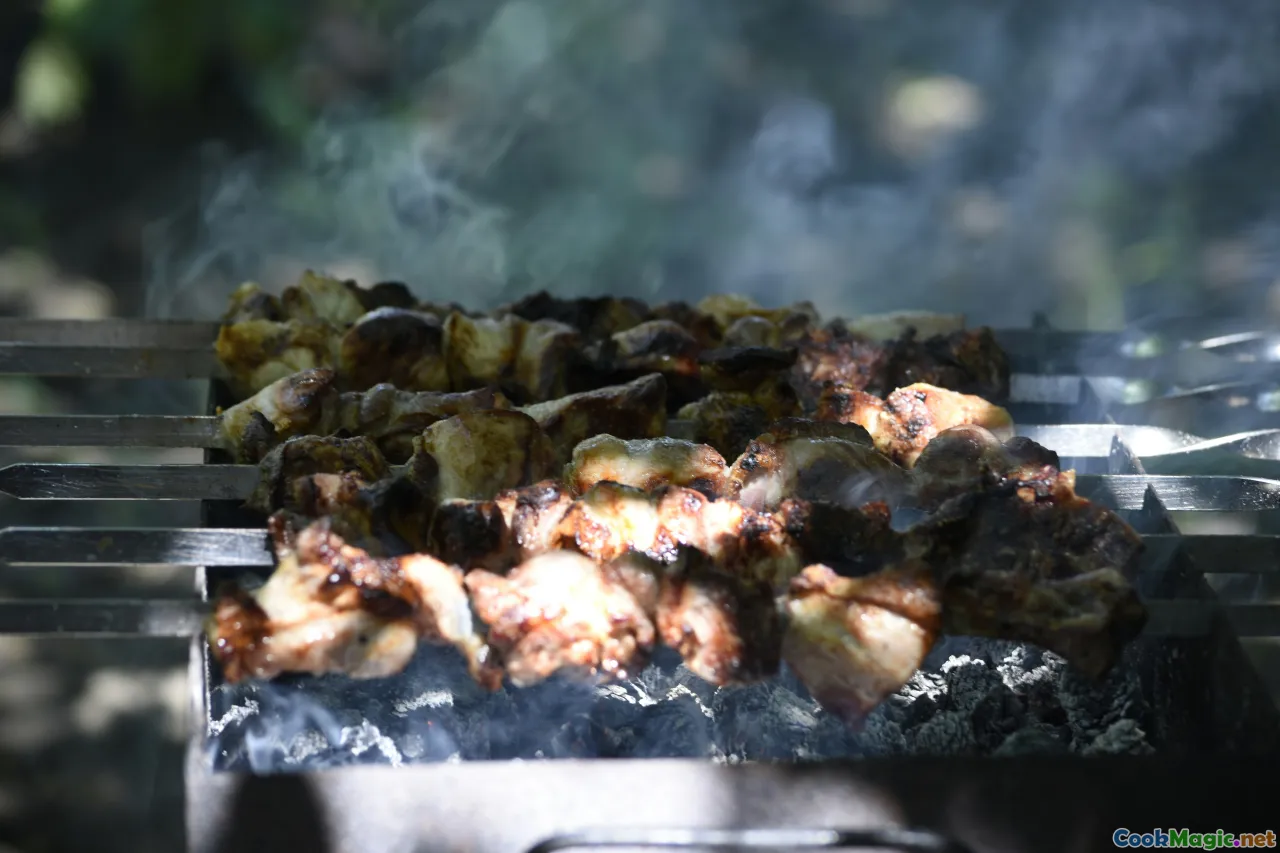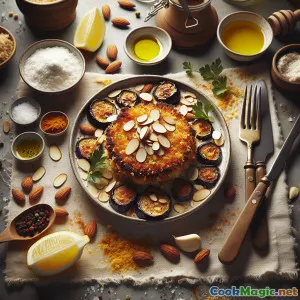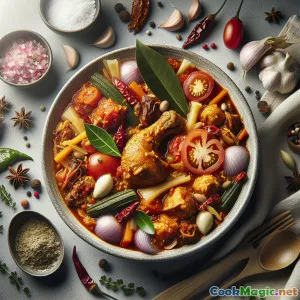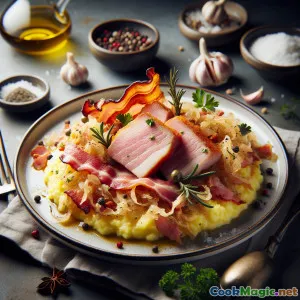
Kastilisches Lammbraten mit Knoblauch
(Garlic-Laced Castilian Lamb Roast)
(0 Bewertungen)0
206
Oktober 07, 2025
Problem melden
Zutaten
-
1400 grams Lammerschulter mit Knochen
(Preferably young lamb for tenderness; trim excess surface fat)
-
12 cloves Knoblauchzehen
(Reserve 2 cloves for the finishing crumb; slice 4 into slivers for lacing)
-
60 ml Natives Olivenöl extra
(Use a fruity Spanish oil for authenticity)
-
150 ml Trockener Sherry (Fino oder Amontillado)
(Can substitute dry white wine if sherry unavailable)
-
2 tsp Geräuchertes spanisches Paprika (Pimentón dulce)
(Adds gentle smoke and color; do not replace with hot paprika unless desired)
-
2 sprigs Frischer Rosmarin
(Strip leaves if large; classic with lamb)
-
4 sprigs Frischer Thymian
(Lends a savory backbone to the roast)
-
2 leaves Lorbeerblätter
(Preferably Spanish laurel; remove before serving)
-
1 tsp Zitronenschale, fein gerieben
(Brightens the rich lamb and garlic)
-
2.5 tsp Grobes Meersalz
(Adjust to taste; divided use)
-
1 tsp Frisch gemahlener schwarzer Pfeffer
(Geteilter Gebrauch)
-
40 grams Semmelbrösel
(Day-old rustic bread, finely ground; for aromatic crust)
-
600 grams Festkochende Kartoffeln, dünn geschnitten
(For a patatas panadera-style bed)
-
200 grams Gelbe Zwiebel, dünn geschnitten
(Sweet Spanish onion preferred)
-
250 ml Hühnerbrühe mit wenig Natrium
(Combines with sherry for a flavorful roasting jus)
-
0.5 tsp Rote Pfefferflocken
(For optional gentle heat)
-
2 tbsp Frischer, gehackter Petersilie
(Zum Garnieren und Frischeverleih)
(Preferably young lamb for tenderness; trim excess surface fat)
(Reserve 2 cloves for the finishing crumb; slice 4 into slivers for lacing)
(Use a fruity Spanish oil for authenticity)
(Can substitute dry white wine if sherry unavailable)
(Adds gentle smoke and color; do not replace with hot paprika unless desired)
(Strip leaves if large; classic with lamb)
(Lends a savory backbone to the roast)
(Preferably Spanish laurel; remove before serving)
(Brightens the rich lamb and garlic)
(Adjust to taste; divided use)
(Geteilter Gebrauch)
(Day-old rustic bread, finely ground; for aromatic crust)
(For a patatas panadera-style bed)
(Sweet Spanish onion preferred)
(Combines with sherry for a flavorful roasting jus)
(For optional gentle heat)
(Zum Garnieren und Frischeverleih)
Nährwerte
- Portionen: 4
- Portionsgröße: 1 Teller (300g)
- Calories: 570 kcal
- Carbohydrates: 0 g
- Protein: 38 g
- Fat: 35 g
- Fiber: 3 g
- Sugar: 3 g
- Sodium: 720 mg
- Cholesterol: 120 mg
- Calcium: 70 mg
- Iron: 3.4 mg
Anweisungen
-
1 - Lace the lamb with garlic:
Pat the lamb dry. With a small knife, make 10–12 shallow incisions all over. Insert slivers from 4 garlic cloves into the cuts, pressing them in so they sit just below the surface.
-
2 - Make the garlic-paprika paste:
Crush 6 garlic cloves with 1.5 tsp salt in a mortar to a paste. Stir in paprika, lemon zest, 2 tbsp olive oil, and half the pepper. Rub this paste over the lamb, coating all sides.
-
3 - Prepare the Roasting Bed:
Toss the sliced potatoes and onions with 1 tbsp olive oil, a pinch of salt, the remaining pepper, and the thyme leaves (strip from sprigs). Spread evenly in a large roasting pan or clay cazuela. Tuck in bay leaves and rosemary.
-
4 - Set the stage:
Preheat oven to 220°C (425°F). Place the lamb on top of the potatoes. Pour the sherry and stock around (not over) the lamb to keep the paste intact.
-
5 - Initial high-heat roast:
Roast at 220°C until the lamb begins to brown and the liquids start bubbling. This kickstarts rendering and lightly crisps the garlic-studded exterior.
-
6 - Slow roast and baste:
Reduce oven to 170°C (340°F). Roast until the lamb is tender, basting with pan juices every 15 minutes. Add a splash of water if the pan starts to dry. Potatoes should soften and absorb flavor.
-
7 - Mix the garlic crumb:
Finely grate or mince the remaining 2 garlic cloves. Combine with breadcrumbs, remaining olive oil, and red pepper flakes (if using). Season lightly with salt. The mixture should be damp, not wet.
-
8 - Crust the lamb:
Remove the pan briefly. Sprinkle and press the garlic crumb over the top of the lamb. Return to the oven for 5–8 minutes, or broil 1–2 minutes, until golden and aromatic.
-
9 - Rest and finish:
Transfer the lamb to a board, tent with foil, and rest 10 minutes. If potatoes need more color, keep roasting them while the lamb rests. Discard bay and woody rosemary stems.
-
10 - Carve and Serve:
Carve the lamb into thick slices or pull into chunks. Spoon potatoes and onions onto plates, top with lamb, drizzle with pan juices, and garnish with parsley.
Pat the lamb dry. With a small knife, make 10–12 shallow incisions all over. Insert slivers from 4 garlic cloves into the cuts, pressing them in so they sit just below the surface.
Crush 6 garlic cloves with 1.5 tsp salt in a mortar to a paste. Stir in paprika, lemon zest, 2 tbsp olive oil, and half the pepper. Rub this paste over the lamb, coating all sides.
Toss the sliced potatoes and onions with 1 tbsp olive oil, a pinch of salt, the remaining pepper, and the thyme leaves (strip from sprigs). Spread evenly in a large roasting pan or clay cazuela. Tuck in bay leaves and rosemary.
Preheat oven to 220°C (425°F). Place the lamb on top of the potatoes. Pour the sherry and stock around (not over) the lamb to keep the paste intact.
Roast at 220°C until the lamb begins to brown and the liquids start bubbling. This kickstarts rendering and lightly crisps the garlic-studded exterior.
Reduce oven to 170°C (340°F). Roast until the lamb is tender, basting with pan juices every 15 minutes. Add a splash of water if the pan starts to dry. Potatoes should soften and absorb flavor.
Finely grate or mince the remaining 2 garlic cloves. Combine with breadcrumbs, remaining olive oil, and red pepper flakes (if using). Season lightly with salt. The mixture should be damp, not wet.
Remove the pan briefly. Sprinkle and press the garlic crumb over the top of the lamb. Return to the oven for 5–8 minutes, or broil 1–2 minutes, until golden and aromatic.
Transfer the lamb to a board, tent with foil, and rest 10 minutes. If potatoes need more color, keep roasting them while the lamb rests. Discard bay and woody rosemary stems.
Carve the lamb into thick slices or pull into chunks. Spoon potatoes and onions onto plates, top with lamb, drizzle with pan juices, and garnish with parsley.
Mehr über: Kastilisches Lammbraten mit Knoblauch
The Story and Spirit of Garlic Laced Castilian Lamb
Garlic Laced Castilian Lamb channels the heart of Spain’s high plateaus, where roast lamb is more than a dish—it’s a tradition. From Castile’s wood-fired ovens to modern home kitchens, the core idea remains the same: let quality lamb and honest aromatics do the heavy lifting. This recipe celebrates “asado” sensibilities with a few refinements: lacing the shoulder with slivers of garlic, anointing it with a paprika-forward paste, and resting it on a bed of potatoes and onions that drink up sherry and stock. The result is a centerpiece meal that’s simultaneously rustic and elegant.
Why This Recipe Works
- Lacing with garlic: Studding the meat ensures deep, pinpoint flavor that doesn’t burn on the surface. It perfumes the interior and brings old-world charm to the roast.
- Paprika-garlic paste: Spanish pimentón dulce offers color and a whisper of smoke, while lemon zest brightens and keeps richness in check.
- Two-stage roasting: A blast of high heat browns and renders; a lower, steadier temperature coaxes tenderness without drying the shoulder.
- Aromatic bed: Potatoes and onions—Castilian staples—become “patatas panadera,” soaking up juices, sherry, and herb-laced stock for a side that tastes like the roast’s memory.
- Garlic crumb finish: A quick, golden crust intensifies the garlic theme and adds texture without overpowering the lamb.
Ingredients with Provenance
- Lamb shoulder: In Castile, young lamb (lechazo) is prized for delicate flavor. Shoulder is forgiving, succulent, and deeply flavorful when slow-roasted.
- Pimentón: Spain’s smoked paprika from La Vera lends authenticity and a gentle smoke that evokes wood-fired ovens.
- Sherry: A dry fino or amontillado ties the region’s culinary history to the plate; it brings nutty depth that wine alone can’t replicate.
- Herbs: Rosemary, thyme, and bay echo traditional roasts served during festivities and Sunday gatherings.
Technique Notes and Tips
- Trim, don’t strip: Keep a thin cap of fat for self-basting, but remove thick, waxy deposits that won’t render well.
- Mortar over machine: Crushing garlic with salt in a mortar creates a sticky paste that adheres better than a processor blend.
- Add liquid around, not over: This preserves the spice paste and encourages even browning.
- Basting cadence: Every 15 minutes during the low phase redistributes flavor and keeps the potatoes moist.
- Crumb control: The garlic breadcrumb should be damp enough to clump but not soggy; add a teaspoon of oil if too dry.
Make-Ahead and Scaling
- Season ahead: You can lace and paste the lamb up to 12 hours in advance—refrigerate uncovered for a lightly dried, browning-friendly surface. Bring to room temperature before roasting.
- For a crowd: Roast multiple shoulders in separate pans to prevent steaming; rotate pans halfway for even heat.
- Reheating: Warm slices in a covered dish with a splash of stock at 150°C (300°F) to keep moisture.
Variations
- Hotter profile: Swap half the sweet paprika for hot pimentón picante or add more red pepper flakes.
- Herb twist: Replace thyme with savory or add crushed fennel seeds for a Castilian-meets-Mediterranean nuance.
- Citrus lift: Stir a spoon of orange zest into the paste for a brighter, festive note.
- Wine alternative: A dry white Rioja or Verdejo makes a good stand-in for sherry.
Serving and Pairings
Serve the lamb over the pan-roasted potatoes and onions, spooning over the sherry-kissed jus. A crisp green salad with sherry vinaigrette cuts richness. Pair with Ribera del Duero or Rioja—wines with enough structure to match lamb’s depth and the smoky paprika.
Cultural Significance
In Castile and León, lamb roasts usher in family gatherings, holidays, and Sundays. Clay cazuelas and wood-fired ovens remain iconic, but the soul of the dish translates perfectly to a modern oven: simplicity, patience, and respect for the animal. Garlic—Spain’s aromatic cornerstone—binds this dish to its landscape, telling a story of shepherding, communal tables, and harvests.
Troubleshooting
- Pale surface: Your oven may run cool. Ensure the initial high-heat phase is robust or finish with a brief broil.
- Dry texture: Shoulder needs time at a moderate temperature; don’t skip basting, and don’t over-trim fat.
- Soggy potatoes: Spread in a thin, even layer and avoid over-crowding; if needed, finish uncovered on a higher rack while the lamb rests.
Sustainability & Sourcing
Seek ethically raised lamb from local producers if possible; younger lamb yields tenderness, but shoulder from mature animals can be exceptional when slow-cooked. Good olive oil and genuine pimentón make an outsized difference—small upgrades with big returns.
Final Thoughts
Garlic Laced Castilian Lamb honors tradition while leaning into layered garlic techniques—lacing within, pasting without, and crowning on top. The potatoes become a testimonial to the roast, capturing every savory drip. It’s a dish to gather around: unfussy, fragrant, and irresistibly generous—just like Castile itself.
